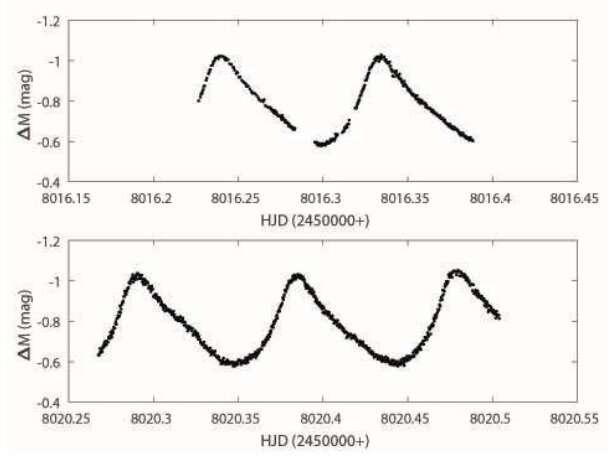March 23, 2020 report
V2455 Cyg is a high amplitude Delta Scuti star, new observations suggest

Using the Research Institute for Astronomy and Astrophysics of Maragha (RIAAM) Observatory, Iranian astronomers have performed new photometric observations of the variable star V2455 Cyg. Results of the observational campaign suggest that the studied object is a high-amplitude Delta Scuti star. The finding is reported in a paper published March 17 on the arXiv pre-print server.
Observations of variable stars could offer important hints into aspects of stellar structure and evolution. They could be also helpful for better understanding of the distance scale of the universe.
V2455 Cyg (also known as GSC 03590-01884, TYC 3590-1884-1 or HD 204615) is a pulsating star located some 700 light-years away, first spotted in 1991. Based on previous observations, V2455 Cyg was classified as an SX Phoenicis (SX Phe) variable (a subclass of Delta Scuti variable), given that it has a relatively short period of about 0.09 days, is of spectral type of F2, and has a high space velocity at a level of 32 km/s.
Now, a new study conducted by a team of astronomers led by Ghasem Forozani of Payame Noor University (PNU) in Tehran, Iran, confirms that V2455 Cyg and sheds more light on its properties. For their study, the researchers employed the RIAAM Observatory's Meade LX200 Schmidt-Cassegrain Telescope equipped with a SBIG STX-16803 CCD camera.
"In this paper, we presented new observations of V2455 Cyg, obtained times of maximum light and investigated the changes of the pulsation period. We also analyzed the pulsation frequency of V2455 Cyg and determined physical parameters of this Delta Scuti star," the paper reads.
First of all, the study found that the period of V2455 Cyg is increasing at a rate of approximately 0.0000002 days per year. The astronomers emphasize that such a slowly increasing period is in agreement with period changes in the majority of known Delta Scuti stars.
The fundamental frequency of V2455 Cyg was calculated to be about 10.61/day and its pulsation constant was estimated at approximately 0.033 days. This, according to the authors of the paper, indicates that the variable pulsates with the radial p-mode.
The study also determined physical parameters of V2455 Cyg. The researchers estimated that this variable, at its mean temperature of 7,490 K, has a radius of about 2.52 solar radii, a mass of around 1.92 solar masses, and luminosity approximately 18 times greater than that of the sun.
Taking into account all the new results, the astronomers concluded that V2455 Cyg is a is a high-amplitude Delta Scuti (HADS) star, which was proposed by one previous study. They endorse more photometric and spectroscopic observations of this variable in order to confirm this scenario.
More information: New CCD Photometric Investigation of High Amplitude δ Scuti Star V2455 Cyg, arXiv:2003.06704 [astro-ph.SR] arxiv.org/abs/2003.06704
© 2020 Science X Network





















